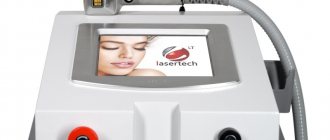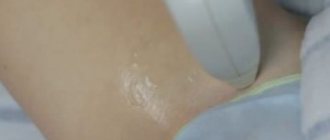Laser treatment of the hair follicle is an effective and safe method for removing unwanted hair on any part of the body. For those wishing to get rid of excess hair, it is useful to find out how many times laser hair removal needs to be done, what is the frequency of sessions for the most successful result. How often to repeat laser hair removal in order to remove hairs faster - there are many questions, but there is nothing secret about them.
Feelings during processing
Many people hesitate to undergo the procedure because they believe that laser hair removal in the bikini area causes unbearable pain. In fact, it depends on the sensitivity of the skin and the pain threshold. Some describe the procedure as a slight unpleasant tingling sensation, others say that the pain was very severe.
Fear of the procedure increases discomfort, so you need to be positive.
The use of anesthesia depends on the type of treatment. If they do the classics, then anesthesia is not necessary; it is done if the skin is hypersensitive. When treating a deep bikini, the use of local anesthesia is recommended.
In beauty salons they use anesthetics: Emla cream, Acriol pro and others.
How many sessions are needed to permanently remove hair?
Laser hair removal is a method of radical hair removal that involves the destruction of hair follicles using laser radiation. During the procedure, laser beams affect only the hair follicle. Melanin, which is responsible for the color of hair and skin, absorbs laser energy, which, in turn, is transformed into heat, which destroys the hair follicle.
One laser hair removal procedure will most likely have no effect on the degree of hair growth in a certain area. Laser radiation affects only those hair follicles that are in the active growth phase. Usually their number is about 20% of the total amount of hair. During the first procedure, part of the follicles that are in the active stage is destroyed. This stimulates the activation of dormant follicles, resulting in compensatory hair growth.
To see the first positive results of laser hair removal, you need to perform at least 3 – 4 procedures, after which the following will become noticeable:
- decreased hair growth rate;
- reduction in thickness, length, color intensity, etc.
To stop hair growth for as long as possible, you need to undergo a full course of laser hair removal procedures. The doctor will determine exactly how many laser hair removal procedures are needed, taking into account the individual characteristics of the patient’s body.
Which technology has the best price/quality ratio?
Today there are dozens of lasers from different manufacturers. But they can all be reduced to several types: alexandrite, diode, neodymium, Elos, AFT, IPL and IPLASER. We only use lasers with the IPLASER system as they are safe, effective and painless. Our specialists are qualified physicians, as it is important to assess the risk and possibility of laser hair removal individually for each client.
Find out prices for laser hair removal
Why are multiple treatments required?
The laser acts on the regrown hair and its follicles, of which there are no more than 25% on the skin area. Ungrown hair is at rest under the protection of the skin. Soon, new hairs appear on the areas treated with the device. To get rid of hair for a long time, it is necessary to repeat sessions of the cosmetological method several times.
The answer to the question of how long it takes to do laser hair removal depends on many factors, taking into account which it will be possible to get rid of unwanted hair for a long time.
Aftercare
Care after laser hair removal for bikini with total hair removal is aimed at relieving irritation and maintaining skin health.
Rules of care:
- For 2-4 days, use sedatives such as Bepanthen cream;
- You can wash in the shower with warm water after 24 hours, but take a bath or go to the sauna only after 7 days;
- The treated area may be very itchy. It is important to prevent scratching, so use products to relieve skin irritation;
- You can sunbathe no earlier than after 2 weeks;
- At first, wear only cotton underwear;
- Remove remaining hair after the procedure only with a razor or trimmer.
If something unusual begins to happen to the skin in the area of laser exposure - blisters, rashes or severe irritation - you should immediately consult a doctor.
Is there a risk of ingrown hairs, folliculitis or skin cancer?
There is no risk of ingrown hairs. Moreover, the laser gets rid of them too. If the hair is not too deep, then the light reaches it, the hair dies and gradually the skin pushes it to the surface. Depending on the severity of the case, these ingrown hairs can go away for a period of 1 to 8 months.
Folliculitis can have a bacterial, fungal, viral or parasitic etiology, but laser cannot cause it. However, if you have a disease, laser hair removal is not recommended, so as not to aggravate the situation. In this case, it is better to consult a dermatologist. We have such a specialist in our studio; the first consultation is free. Regarding cancer: this is one of the most common concerns. No, the laser does not cause cancer, its light is harmless, this is officially confirmed by Rostest. The laser uses infrared light, while skin cancer is caused by ultraviolet light. You are more likely to harm yourself by spending long periods of time in the sun or in a tanning salon than by having laser hair removal treatments. Moreover, it is held only once a month. Laser hair removal also does not affect internal organs, since the light does not pass so deeply - maximum to the lower layers of the epidermis.
Which parts of the body can be removed with laser hair and which parts cannot?
Using a laser, you can remove hair from any part of the body, even on the labia of women, in the nose or ears. The exception is the eyes. Since the skin around the eyes is very thin, to avoid the risk of any damage or consequences, we do not epilate the hair under the eyebrows, but we can do it between and above.
Contraindications and possible consequences
The procedure for removing body hair using a laser is not harmless. There are contraindications for laser hair removal of deep bikini:
- Taking retinoids;
- Diabetes. With a systemic disease, immunity is greatly reduced, so complications often develop;
- Any type of oncology;
- Any other immunodeficiency conditions - in case of reduced immunity, hair removal should not be carried out;
- Acute infectious diseases - for example, influenza, sore throat;
- STIs, genital infections. Exposure to a laser can intensify the manifestations of the disease;
- Dermatological diseases - eczema, dermatitis, herpes, etc.;
- Pregnancy and lactation period. During this period of a woman’s life, any interventions are undesirable; there is a complete ban on hardware cosmetic procedures;
- Epilepsy, convulsive syndromes, that is, diseases associated with involuntary muscle contraction;
- The presence of wounds, scratches, scratches and any other damage to the skin in the treatment area;
- Severe diseases of the cardiovascular system;
- Laser hair removal is prohibited for minors.
If all contraindications are excluded, you get a safe and highly effective procedure.
The negative consequences of a deep bikini arise when the procedure is performed incorrectly.
Possible:
- Burns;
- Hyperpigmentation (darkening of the skin);
- Inflammatory reactions;
- Loss or impairment of vision.
Visual impairment occurs if safety glasses are not used during processing.











